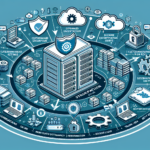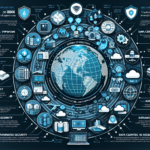Securing IT infrastructure for financial institutions is critical due to the sensitive nature of the data they handle, the regulatory requirements they must adhere to, and the increasing sophistication of cyber threats. As an IT manager responsible for such infrastructure, you need to adopt a comprehensive, multi-layered approach to security. Below is a detailed guide to help secure IT infrastructure for financial institutions:
1. Understand Regulatory and Compliance Requirements
- Know the regulations: Familiarize yourself with industry-specific regulations such as PCI DSS, GDPR, ISO 27001, SOX, or local regulations specific to your country (e.g., FFIEC in the U.S.).
- Audit readiness: Ensure systems, policies, and processes are compliant with regulatory requirements to avoid penalties.
- Regular compliance checks: Conduct periodic audits and assessments to ensure ongoing compliance.
2. Implement Strong Access Controls
- Role-based access control (RBAC): Limit access based on roles and responsibilities. For example, only database administrators should have access to sensitive financial databases.
- Multi-factor authentication (MFA): Enforce MFA for all critical systems and user accounts, including internal and external users.
- Principle of least privilege: Grant users and applications the minimum level of access required to perform their duties.
- Privileged access management (PAM): Implement solutions to manage and monitor privileged accounts.
3. Network Security
- Segmentation: Segment networks to isolate sensitive systems such as payment processing servers, customer databases, or backup storage from less critical systems.
- Firewalls and intrusion detection/prevention systems (IDS/IPS): Deploy advanced firewalls and IDS/IPS solutions to monitor and block suspicious activity.
- Zero Trust Architecture: Adopt Zero Trust principles to verify every connection and user before granting access.
- VPNs: Use secure VPNs for remote access, ensuring encrypted communication channels.
4. Endpoint Security
- Endpoint protection: Deploy antivirus, anti-malware, and endpoint detection and response (EDR) solutions.
- Patch management: Regularly patch operating systems, applications, and firmware to address vulnerabilities.
- Device encryption: Enforce full-disk encryption for laptops, desktops, and mobile devices.
5. Data Protection
- Encryption: Encrypt data at rest and in transit. Use strong encryption protocols such as AES-256.
- Data masking: Mask sensitive data (e.g., customer financial data) in non-production environments.
- Data loss prevention (DLP): Implement DLP solutions to detect and prevent unauthorized data transfers.
- Backup and disaster recovery: Maintain regular backups and test disaster recovery plans to ensure availability in case of data loss or ransomware attacks.
6. Server and Virtualization Security
- Harden servers: Disable unnecessary services, ports, and accounts. Ensure secure configurations for Linux and Windows servers.
- Virtualization security: Secure hypervisors, isolate virtual machines (VMs), and monitor VM activities. Use tools like VMware vSphere or Microsoft Hyper-V with built-in security features.
- GPU security: Protect servers with GPU cards used for high-performance computing or AI workloads by monitoring driver updates and ensuring secure configurations.
7. Kubernetes and Container Security
- Namespace isolation: Use namespaces to isolate workloads within Kubernetes clusters.
- Pod security policies: Define strict policies to restrict container privileges and enforce security configurations.
- Image scanning: Scan container images for vulnerabilities before deployment.
- Runtime monitoring: Use tools like Falco or Aqua Security to monitor container behavior during runtime.
8. AI and Advanced Threat Detection
- Threat intelligence: Use AI-driven threat intelligence platforms to detect and respond to emerging threats.
- Behavioral analytics: Implement AI tools to monitor unusual behavior in systems, networks, or user activities.
- Automated response: Use AI-powered SOAR (Security Orchestration, Automation, and Response) tools to automate incident response.
9. Backup and Recovery
- Immutable backups: Maintain immutable backups to protect against ransomware attacks.
- Air-gapped backups: Store critical backups offline or in isolated environments.
- Replication: Use replication across multiple geographic locations for high availability and disaster recovery.
10. Continuous Monitoring and Logging
- SIEM solutions: Deploy Security Information and Event Management (SIEM) tools like Splunk, ELK Stack, or Microsoft Sentinel for real-time monitoring.
- Log management: Collect and analyze logs from servers, network devices, applications, and security tools to detect anomalies.
- 24/7 monitoring: Ensure that security operations are monitored round-the-clock, either in-house or via a managed security service provider (MSSP).
11. Employee Training and Awareness
- Phishing simulations: Conduct regular phishing tests to educate employees on recognizing social engineering attacks.
- Security training: Provide ongoing cybersecurity training for employees, including best practices for handling sensitive data.
- Incident reporting: Encourage employees to report suspicious activities immediately.
12. Incident Response Planning
- Incident response team: Establish a dedicated team with clear roles and responsibilities for handling security incidents.
- Runbooks: Develop and maintain incident response playbooks for common scenarios like ransomware, data breaches, or DDoS attacks.
- Testing: Conduct regular tabletop exercises and penetration tests to evaluate the effectiveness of your response plans.
13. Vendor and Third-Party Risk Management
- Third-party assessments: Evaluate the security posture of vendors and partners who access your systems or data.
- Contracts: Include cybersecurity clauses in contracts, requiring vendors to follow best practices.
- Continuous monitoring: Monitor third-party access and ensure compliance with agreed security measures.
14. Physical Security
- Access controls: Use biometric access, keycards, or PINs for datacenter access.
- Surveillance: Maintain CCTV monitoring and intrusion detection systems for physical premises.
- Environmental controls: Protect hardware from environmental risks like fire, water damage, or power outages.
15. Regular Vulnerability Assessments and Penetration Testing
- Vulnerability scans: Conduct regular scans on servers, networks, and applications to identify weaknesses.
- Penetration testing: Simulate attacks to identify gaps in your defenses.
- Remediation: Prioritize and address vulnerabilities promptly.
16. Stay Updated
- Threat intelligence: Subscribe to threat intelligence feeds to stay ahead of emerging threats.
- Patch cycles: Monitor updates from vendors and apply patches immediately for critical vulnerabilities.
- Community engagement: Participate in financial sector security forums to share knowledge and best practices.
17. Budget and Resource Allocation
- Invest in security tools: Allocate adequate budget for cybersecurity tools and infrastructure upgrades.
- Hire experts: Build a skilled cybersecurity team or work with specialized consultants if necessary.
By implementing these practices, you can significantly enhance the security posture of the IT infrastructure for financial institutions and protect sensitive data from threats. Security is an ongoing process, so ensure regular reviews and updates to your strategy.



